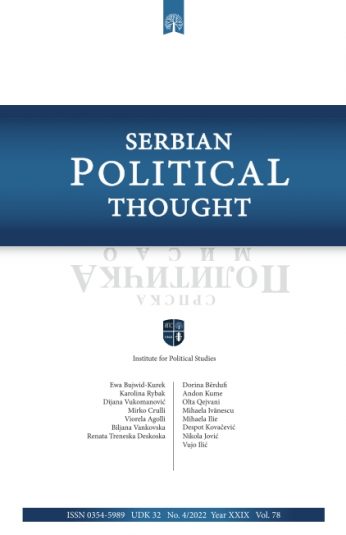Main topic
spt2/2012
Serbia Between Electoral Authoritarianism and Consolidated Democracy
Abstract
Transition from mono-organisational, single-party, ideological and authoritarian regimes into plural, competitive and democratic systems has proven a far more complex and uncertain process, with a far higher social price than the analysts, and especially citizens of the transition countries expected and desired. In this text, starting from different qualitative and quantitative criteria and indicators for “democracy measuring”, the author formulates and argues an assessment that after two decades of transitional roaming, Serbia is just a “deficient”, semi-consolidated democracy, and he suggests the elements of “exit strategy” from the status of democratic deficit.
References
- Beetham, D. (1999) Democracy and Human Rights Cambridge: Polity Press
- Beyme, K. (2007) Suvremeni oblici predstavničke demokracije. Zagreb: Anali Hrvatskog politološkog društva.
- Blue Bird Project (2004) Zamka nefleksibilnosti. Beograd: UNDP – BFPE.
- Diamond, L. (1999) Developing Democracy. Baltimore: The Johns Hopkins University Press.
- Đinđić. Z. (2007) „Uloga nevladinih organizacija u demokratskom društvu“. In Paunović, Ž. (ed.): Budućnost civilnog društva u Srbiji. Niš: Milenijum.
- Hantington, S. (2004) Treći talas. Beograd: Stubovi kulture.
- Keane, J. (2007) Prijedlog za pravno promišljanje podrijetla i budućnosti predstavničke vladavine. Zagreb: Anali Hrvatskog politološkog društva.
- Linz, (2000) Totalitarian and Authoritarian Regimes. Boulder, Colorado: Lynne Rienner Publishers.
- Linc, H. i Stepan, (1998) Demokratska tranzicija i konsolidacija. Beograd: Filip Višnjić.
- Lajphart, A. (2003) Modeli demokratije. Beograd: Sužbeni list SCG – Podgorica: CID.
- Migdal, J. (1988) Strong Society and Weak States : State – Society Relation and State Capabilities in Third World. Princeton , Princeton University Press.
- Pavlović, V. (2006) Civilno društvo i demokratija. Beograd, Službeni glasnik, 2006.
- Pavlović, D. and Antonić, S. (2007) Konsolidacija demokratskih ustanova u Srbiji posle 2000. Godine. Beograd: Službeni glasnik.
- Przeworski, A. (1988) “Democracy as a Contigent Outcome of Conflict”. In: Elster, J. and Slagstad, R. (eds.) Constitution and Democracy, Cambridge: Cambridge University Press.
- Przeworsky, A. (2004) “Democracy and economic development”. In : Mansfield, E. D. and Sisson, R. (eds.) The Evolution of Political Knowledge. Columbus: Ohio State University Press.
- Schedler, A. (2001) “What is democratic consolidation?”. In: Diamond, L. and Plattner, M. (eds.) The Global Divergence of Democracy. Columbus: The John Hopkins University Press.
- Schmitter, C. and O’Donnell, G. (1986) Transition from Authoritarian Rule. Tentative Conclusion About Uncertain Democracies. Baltimore: The Johns Hopkins University Press.
- Stojiljković, Z. (2007) „Civilno društvo i konsolidovanje demokratije“. In: Paunović, Ž. (ed.) Budućnost civilnig društva u Srbiji, Beograd: Milenijum, Centar za razvoj građanskog društva.
- Stojiljković, Z. and Mihailović, S. (2010) Stanje socijalnog dijaloga u Srbiji posle dvadeset godina tranzicije. Beograd: SLA.
- Vujačić, I. (2009) „Dokle smo stigli u konsolidaciji demokratije?“. In: Fokus: kvartalni izveštaj o institucionalnim reformama. Beograd: Centar za liberalno-demokratske studije. pp. 10–14.
- Wolfgang M., Puhle H. J. et al. (2003) Defekte Demokratie, Band 1: Theorie. Opladen: Leske + Budrich.

